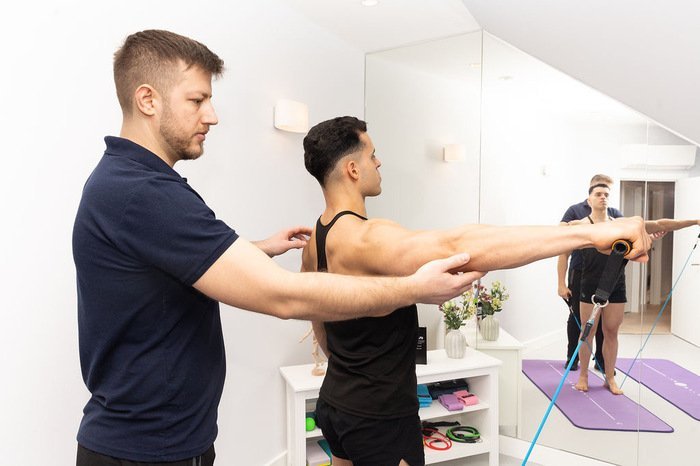Specialist Physiotherapy Techniques for Boosted Stamina and Well-Being
The domain of specialist physical rehabilitation includes a selection of strategies created to improve both toughness and overall health. Central to this technique is the understanding of customized treatment strategies that incorporate resistance training, hands-on treatment, and practical exercises, each offering unique duties in rehab.
Understanding Physiotherapy Concepts
Physiotherapy principles are grounded in an all natural understanding of the human body and its reaction to injury and recovery. These principles emphasize the interconnectedness of physical, psychological, and social variables that influence an individual's wellness. An essential aspect of physical rehabilitation entails examining the client's overall condition, recognizing disabilities, and developing tailored treatment strategies that help with recovery and improve function.
At the core of physical rehabilitation is the belief in patient-centered treatment, where specialists proactively include people in their recovery process. This collaborative technique promotes inspiration and motivates adherence to treatment protocols. In addition, physio therapists utilize evidence-based techniques to lead their interventions, making sure that strategies and methods are supported by present study.
Another secret concept is the relevance of movement and function in rehab. Physio therapists concentrate on recovering mobility, strength, and control, acknowledging that optimum physical feature is important for overall well-being. In addition, education and learning plays a crucial role in physical rehabilitation, as practitioners guide clients in comprehending their conditions and embracing healthier way of living options.
Trick Strategies for Strength Structure
Toughness building is an important part of rehab, targeted at boosting muscle feature and total physical performance. Physio therapists employ numerous methods to facilitate this process, tailoring programs to meet specific patient requirements.
One key strategy is resistance training, which includes workouts making use of weights, resistance bands, or body weight to enhance muscle stamina. This technique efficiently targets specific muscle mass groups, promoting hypertrophy and endurance. An additional crucial approach is practical training, which concentrates on workouts that mimic everyday tasks, enhancing the capacity to execute routine tasks with better simplicity and stamina.
Modern overload is also important in strength building. This concept requires slowly increasing the strength of exercises, whether via included weight, increased repeatings, or modified tempo, ensuring regular adaptation and development of muscle mass fibers. In addition, integrating plyometric workouts can boost power and volatility, which is particularly useful for professional athletes and active people.
Lastly, isometric exercises, where muscles contract without altering size, can boost stability and strength in particular joints. By incorporating these methods into personalized rehab programs, physio therapists can effectively sustain patients in achieving their strength-building goals, eventually leading to enhanced useful outcomes and improved quality of life.
Advantages of Guidebook Therapy
Integrating a selection of therapeutic methods improves the overall effectiveness of recovery programs, and guidebook treatment stands out as a valuable strategy. This hands-on intervention contributes in alleviating pain, boosting flexibility, and promoting the healing process.
Manual treatment encompasses various methods, consisting of soft tissue mobilization, joint control, and myofascial release (physio north lakes). These methods intend to decrease muscular tissue stress, improve circulation, and recover functional activity. By resolving soft cells limitations and joint disorders, manual treatment can dramatically contribute to discomfort relief and boosted variety of movement
In addition, the restorative touch associated with hand-operated treatment cultivates a strong patient-provider relationship, advertising trust and convenience. This emotional link can improve individual adherence to rehab methods and general fulfillment with their care.
Study has shown that handbook treatment can be especially effective for problems such as low neck and back pain, neck pain, and tension frustrations. physio north lakes. As a complementary therapy, it can be integrated with various other modalities, such view as workout or modalities, to maximize outcomes. Eventually, the benefits of hands-on treatment highlight its crucial role in thorough physiotherapy therapy strategies, supporting both toughness enhancement and general health
The Role of Exercise Prescription
Workout prescription plays a crucial duty in the recovery process, functioning as a fundamental component for attaining optimal client end results. It involves the systematic planning of exercises customized to the individual demands and capabilities of individuals. By taking into consideration variables such as age, physical condition, and details health goals, physiotherapists produce personalized exercise programs that promote recuperation and boost overall physical well-being.

Moreover, workout prescription cultivates client interaction and ownership of the recovery process. By actively taking part in their recuperation, individuals are extra most likely to comply with suggested regimens, resulting in enhanced end results. In summary, workout prescription is a critical component of physiotherapy, supplying organized, individualized strategies that sustain people in their trip towards enhanced stamina and overall health and wellness.
Integrating Mindfulness in Recuperation
The unification of mindfulness practices into recovery approaches supplies an all natural method to recuperation that matches standard exercise prescription. Mindfulness, specified as the deliberate focus on the present moment, can dramatically improve individual results by fostering greater understanding of bodily sensations and psychological states. This enhanced understanding enables individuals to better identify discomfort signals and stress responses, facilitating extra efficient self-regulation.
Study has shown that integrating mindfulness strategies, such as meditation and concentrated breathing, can decrease anxiety and boost emotional strength during recuperation. These techniques equip patients to take care of discomfort and grow a favorable way of you can try this out thinking, which is crucial for adhering to exercise regimens and attaining long-lasting recovery goals.
Physio therapists can incorporate mindfulness by leading clients with short mindfulness exercises before or after physical treatment sessions. This combination not just help in physical recovery however likewise promotes overall psychological health. Additionally, teaching patients to participate in mindfulness throughout exercises can improve their focus, making certain that movements are done with greater precision and intent.
Verdict
